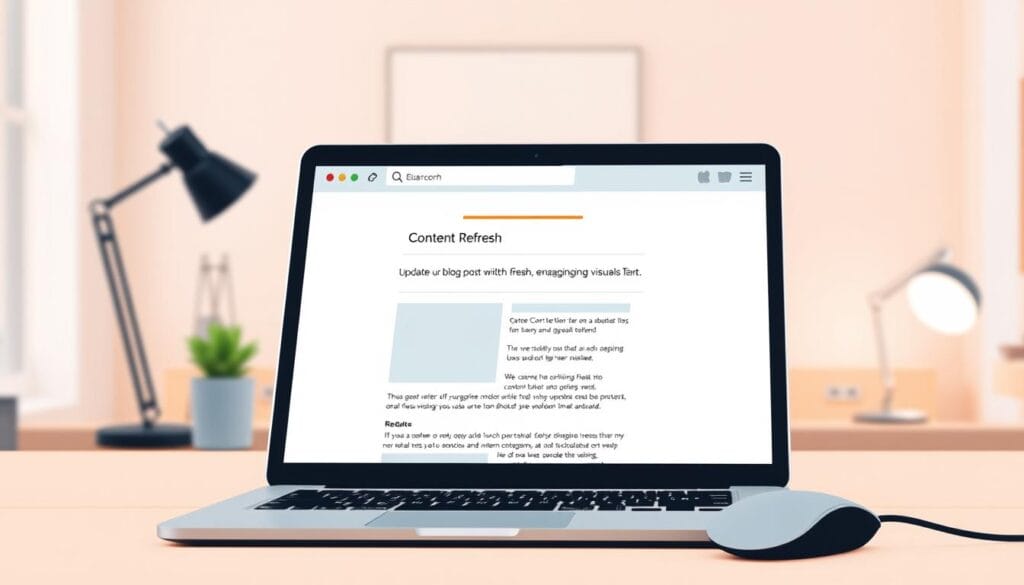Fact: within 12 months many high-performing pages drop in traffic by as much as 30% if not updated—search rewards relevance, not age.
We help high-ticket brands choose between fixing existing assets or launching topics that capture net-new demand. Our approach stops decay and unlocks scalable visibility.
We use audits with GA4, Search Console, Ahrefs and Clearscope to map opportunity. Then we prioritize evergreen, pillar, and landing pages for the fastest ROI.
Expect a pragmatic, E-E-A-T-aligned framework that measures rankings, traffic, engagement, and conversions. We highlight when to consolidate URLs, when to set redirects, and when to chase new topics.
Promise: you will leave with a repeatable system that protects brand equity while accelerating results. Later, explore Macro Webber’s Growth Blueprint or book a consultation for measurable impact.
Key Takeaways
- Stop content decay by auditing traffic and ranking signals.
- Prioritize pages with evergreen intent and clear conversion paths.
- Use the right tools to quantify opportunity and visibility lifts.
- Balance updates with selective topic launches to scale efficiently.
- Measure success by rankings, traffic, engagement, and conversions.
- Align every change with E-E-A-T to sustain premium brand trust.
The high-stakes decision: stop content decay or scale with new topics now
Every quarter teams face one binary: plug the traffic leak on proven pages or invest in topics that create future demand. This is a business call, not an editorial debate.
We use audits—GA4, Search Console, Ahrefs, SEMrush, Screaming Frog—to surface drops in ranking and missed intent. Those signals show where search engines favor fresher results or where competitors outpace you.
Executive decision path:
- We quantify decay risk: top earners slipping in engines raise acquisition costs and need a targeted refresh.
- We isolate the fastest path: update winners sitting in striking distance; build new content when whitespace and product moves demand first-mover advantage.
- We weigh impact vs. lift: light metadata and link updates for small gains; deep overhauls for intent gaps; net-new builds for category bets.
- We use data—trendlines, conversion paths, assisted revenue—to prioritize where each strategy accelerates ranking and performance.
- We keep strategy and marketing aligned to protect brand equity and capture asymmetric opportunities.
“Choose the route that compounds results fastest while laying the foundation for durable growth.”
What a content refresh is today and why it wins in modern search
Updating legacy pages is a strategic lever that compounds organic growth and protects brand equity. We define the work precisely so teams focus on the edits that move the needle.
Definition and scope: a true content refresh modernizes text and media, tightens metadata, repairs broken links, and realigns intent with today’s queries. It also adds fresh information, examples, and descriptive alt text to improve accessibility.

- Scope: restructure headings, simplify language, update images, and fix links to restore authority.
- Search benefit: smarter metadata and schema improve snippets and rankings on search engines while lifting CTR.
- Experience gains: improved readability, faster mobile layout, and clearer CTAs increase conversions and user experience.
- Recency matters: substantial updates—not cosmetic date changes—signal freshness and strengthen E-E-A-T.
- Tools we use: GA4, Search Console, Ahrefs, SEMrush, and Clearscope to audit performance gaps and guide topical depth.
Outcome: a rigorous process that turns legacy assets into growth engines. We pair lived expertise with data to deliver repeatable SEO wins and measurable lift in traffic, engagement, and conversions.
How to diagnose your portfolio: signs you should refresh vs create new
We map every URL to business impact so teams can act where updates yield the quickest ROI. Start with a concise audit plan that turns analytics into clear triggers. Below, we walk through the signal set and the steps to decide.

Traffic, ranking, and engagement signals
Audit organic sessions in GA4. Compare the last 28 and 90 days to spot declines in traffic and on-page performance.
Use google search console to spot query-level ranking shifts and CTR anomalies. Mark pages in striking-distance (positions 4–20).
Dates, seasonality, and decay detection
Review publish date and seasonality. If intent remains steady and the date is old, update the page. If demand is seasonal, schedule edits before the peak.
Intent gaps from SERP and PAA
Analyze SERPs and People Also Ask. Add missing sections, formats, or FAQs when gaps are fixable in-place.
Revenue, conversions, and action thresholds
Use GA4 Path Exploration to trace which posts assisted conversions. Prioritize those for updates. Protect high-value URLs and consolidate duplicates with 301s only when it improves user experience and results.
“Diagnose with data. Act with clarity. Measure the lift.”
| Signal | Tool | Trigger | Action |
|---|---|---|---|
| Declining organic sessions | GA4 | -20% over 90 days | Audit and update headings, CTAs, links |
| Striking-distance ranking | Search Console | Positions 4–20 | Add keyword-focused sections and internal links |
| High assist to conversion | Path Exploration | Assisted revenue detected | Prioritize rewrite and re-index |
Governance note: document every change, record keywords, and request re-index in google search console to capture results quickly.
Content Refresh vs New Content: a practical playbook for quick wins
Quick, measurable edits to pillar and landing pages deliver outsized returns. We triage high-impact pages first: evergreen explainers, pillar hubs, and conversion-focused landing pages that drive revenue.
Immediate tactical step: apply surgical updates—add target keyword variants, sharpen title tags and meta descriptions, and restructure H2/H3 elements to match snippet intent.
- Harden the technical layer: fix broken links, compress images, add descriptive alt text, and verify Core Web Vitals.
- Improve readability: short paragraphs, scannable bullets, and strong above-the-fold summaries to guide the next click.
- Expand depth where it matters: insert sections from PAA, embed diagrams or video to target image packs and featured snippets.
- Orchestrate internal pathways: link authority hubs to refreshed pages and standardize anchor text for context.
Governance and measurement: document all updates, set 301s for consolidated pages, avoid over-optimization, and relaunch via social media with new hooks.
“Triage, execute, measure — repeat.”
Track impact with GA4 and Google Search Console. This step-by-step playbook aligns with E-E-A-T and delivers fast, defensible gains in search and user engagement.
When to write new content to capture net-new demand and topics
We greenlight new pieces when search signals show rising demand that existing pages cannot satisfy.
Trigger conditions: approve new work when emerging queries surge, a product launches, or an audience pain point cannot be resolved by updating an existing asset.
Scalable framework: build pillar pages with interlinked spokes. Map each pillar to lead-gen goals and pick target keywords in positions 11–20 and 4–10 for striking-distance gains.
Format to win: design for SERP features—PAA, featured snippets, comparison blocks—and choose media that fits the intent.
- Use competitive analysis to add original research and expert POV that raises industry authority.
- Plan internal link paths at the brief stage so each asset routes the target audience toward conversion.
- Sync launches with go-to-market to capture peak opportunities and prove ROI quickly with pre/post benchmarks.
“Build where intent and timing align; measure fast, then scale the plays that deliver clear value.”
Measurement, cadence, and tooling to sustain performance gains
Measurement turns tactical edits into predictable business outcomes. We make KPIs non-negotiable and map them to each page so teams can prove lift fast.
Set KPIs: visibility, rankings, traffic, engagement, and conversions
Leading and lagging metrics. We track visibility share, rankings by cluster, qualified traffic, engagement depth, and conversion rate per page.
- Visibility: share of impressions and indexed keyword coverage.
- Rankings: clusters by priority and positions 1–20 for surgical updates.
- Traffic: qualified sessions and assisted paths that feed revenue.
- Engagement: time on page, scroll depth, and bounce-adjusted interaction.
- Conversions: conversion rate per page and assisted conversion value.
Cadence recommendations and tools
We recommend audits quarterly for pillars and twice yearly for supporting pages. Many teams audit twice yearly; over 20% audit more often. Match frequency to volume and risk.
- GA4: funnels, behavior, and attribution for traffic and conversion signals.
- Google Search Console: query diagnostics, CTR, and re-index after an update.
- Ahrefs / SEMrush: opportunity sizing and competitive gap analysis.
- Screaming Frog: technical inventories and page-level audits.
“Standardize reporting, annotate every date and change, and isolate the impact window for true attribution.”
Operational rules: standardize period-over-period reports, enforce QA gates pre-publish, forecast resource split between refresh and net-new, and codify learnings into playbooks to reduce time-to-results.
Conclusion
Decisive action now turns stalled pages into measurable growth engines.
We’ve shown a clear strategy: defend high-value pages with a disciplined refresh and build targeted clusters where search demand is rising.
Results arrive fast: updating text, media, metadata, and links restores rankings and traffic while improving user experience and engagement.
Governance matters. Document every update, use google search re-indexing, and apply redirects only when they add value. Track performance by page and tie results to revenue.
Act now: book Macro Webber’s Growth Blueprint to surface your top 20 refresh candidates and 10 highest-ROI new opportunities in 14 days. Save visibility, reclaim traffic, and outpace competitors.



